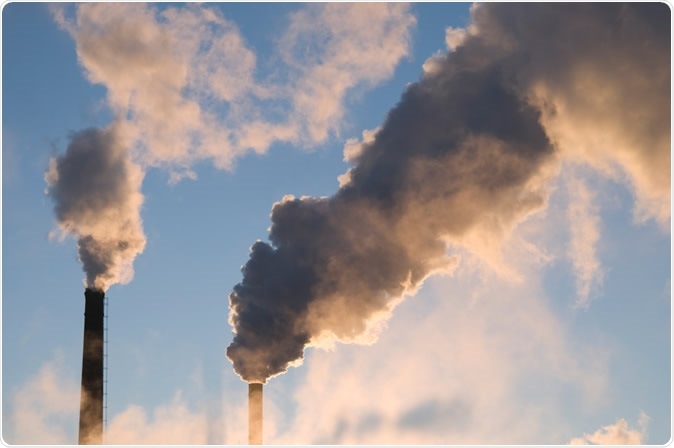Over half the deaths due to poor air quality occurring in the U.S. are because of emissions from outside the state in which the deaths occur, according to a new study published in February 2020 in the journal Nature.
The tendency of air pollutants to cause death across national and international borders is well known. Researcher Steve Barrett says, "It's been well known in Europe for over 30 years that power stations in England would create acid rain that would affect vegetation in Norway."
On the other hand, a detailed and sequential account of this phenomenon especially with regard to human health has not yet been provided, and this motivated the current study.
The researchers looked at the path followed by the emission of a range of air pollutants produced by combustion in various fields, over the period 2005 to 2018. They traced these emissions in every state, from one season to the next, and from one year to the following year.

Image Credit: Erkki Makkonen / Shutterstock
The tool
In the past, it has been difficult to calculate the effects of air pollutants produced in one state on the residents of another. The availability of modern computers and programs has facilitated this work in the current world. This means it is now possible to track the course of emissions from and to each state with respect to the remaining states rapidly and efficiently.
Barrett and his researchers produced such a computational tool inspired by the work of Daven Henze of the University of Colorado at Boulder. This helped them trace the effects of air pollution on health in each state. They looked at sulfur dioxide, ozone, fine particulate matter, and other pollutants from a host of emission sources at fixed intervals for each hour of each day over the whole year.
The sources explored include electric power plants, road transport, ships, railways, airplanes, commercial and residential emissions. The emission data was collected in 2005, 2011 and 2018.
The researchers used the GEOS-Chem atmospheric chemistry model to tell them what became of these emissions at each season and each year. The path of these emissions was tracked based on the wind patterns, and the reactions of the chemicals in the pollutant to the air. They finally used a model derived from epidemiological data to measure the risk of early death due to the exposure of a population to those pollutants.
This model is thus a matrix with many dimensions, and it shows how the emissions from any of these sectors from any state at any time, containing any pollutant, produces an impact on the health measures of another state. Says Barrett, "We can figure out, for example, how much NOx emissions from road transportation in Arizona in July affects human health in Texas, and we can do those calculations instantly."
The findings
The study shows that of the air pollutants produced in one state, over 50 percent is carried through the air into other states. Thus, each state affects the quality of health of people living in other states and contributes to their risk of premature death. And it's not just states across the immediate border that are affected but even those farther away. Different emissions, says Barrett, travel different distances, but some effect states more than a thousand miles away from the state of origin.
The highest risk of death due to emissions occur as a result of electric power generation. In 2005, sulfur dioxide emissions from power plant chimneys caused deaths in other states than the one in which the plant was located in 3 of 4 cases. However, since 2005 the number of early deaths due to air pollution has shown a significant downturn and was almost a third less in 2018. In concrete terms, this means about 30,000 people didn't die earlier than expected because of air pollution.
Moreover, the percentage of deaths due to out-of-state emissions is also declining, from about 53 percent in 2005 to about 41 percent in 2018. The reason may be stricter regulation of emissions from electric power plants. For instance, the Clean Air Act is a regulation passed by the Environmental Protection Agency (EPA), which is a chief contributor to reducing emissions from this sector, among other laws. Barrett says, "Regulators in the U.S. have done a pretty good job of hitting the most important thing first, which is power generation, by reducing sulfur dioxide emissions drastically, and there's been a huge improvement, as we see in the results."
However, emissions from other sources are now on the rise, wafting across state lines to cause deaths in other locations. According to Barrett, vehicles, industrial emissions, and residential emissions are now areas of concern.
Power plants send air pollutants high into the air so that these have the most extended range. Polluting emissions from houses and shops have a limited range, in contrast, because their chemicals react rapidly with gases in the air.
The states that caused a higher number of deaths in other states compared to the negative impact of other states on their population include North Dakota and Wyoming, the northern states of the Midwest. These states have a relatively lower number of people living in them, and because winds sweep away their emissions to other states.
On the other hand, net importer states include the East Coast states because of the winds traveling east, bringing emissions from other states to them. In particular, New York imports air pollution responsible for 60 percent of her deaths due to this cause.
The implications
Barrett says their team has set up a massive database for use by people concerned with public health. He concludes, "We think there are a lot of things that policymakers can dig into, to chart a path to saving the most lives."
Journal reference:
Dedoussi, I.C., Eastham, S.D., Monier, E. et al. Premature mortality related to United States cross-state air pollution. Nature 578, 261–265 (2020). https://doi.org/10.1038/s41586-020-1983-8